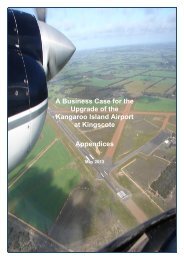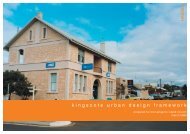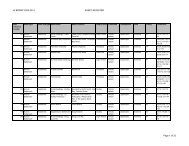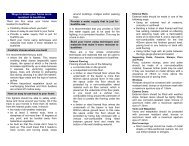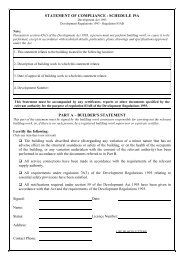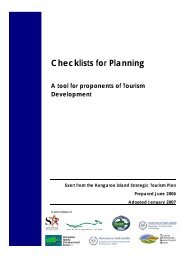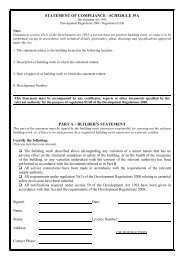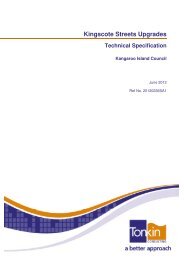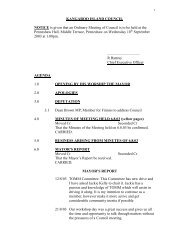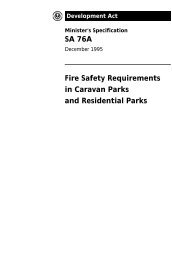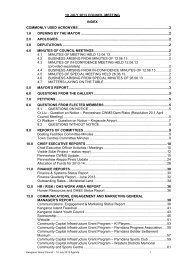Kingscote Airport Master Plan Apr 2010 - Kangaroo Island Council
Kingscote Airport Master Plan Apr 2010 - Kangaroo Island Council
Kingscote Airport Master Plan Apr 2010 - Kangaroo Island Council
Create successful ePaper yourself
Turn your PDF publications into a flip-book with our unique Google optimized e-Paper software.
KINGSCOTE AIRPORT MASTER PLAN<br />
South Australian based passengers are likely to prefer Adelaide as their port of origin while<br />
International and interstate passengers may have a preference for either Melbourne or<br />
Sydney. So even if half the passengers originated from interstate, it only generates 1.5<br />
flights per day using optimistic forecast. The demand is unlikely to warrant an expected<br />
capital outlay of between $10M and $20M for infrastructure needed to allow introduction of<br />
regional jets.<br />
So at this stage unless there is significant shift in passenger demand, it is unlikely we will see<br />
regional jets operating regularly into <strong>Kingscote</strong> within the 15 to 20 year <strong>Master</strong> <strong>Plan</strong> study<br />
period.<br />
The Role of Executive Jets<br />
These aircraft currently operate on an occasional basis into <strong>Kingscote</strong>, primarily servicing the<br />
high end resort market. Provided operating times do not clash with scheduled flights, the<br />
existing passenger facilities at <strong>Kingscote</strong> will generally be satisfactory.<br />
The ability of the aircraft pavements to cope with increased loads and tyre pressures<br />
becomes an issue when larger corporate jets such as the Gulfstream IV are proposed.<br />
Those aircraft requiring stronger pavements, greater runway lengths etc, may need to look at<br />
alternatives as their numbers are unlikely to generate enough revenue to the airport through<br />
landing charges to justify additional infrastructure solely for these occasional aircraft.<br />
Details of the weight and passenger capacity of existing and possible future aircraft for<br />
<strong>Kingscote</strong> are listed in Table 1:<br />
Critical Aircraft Recommendation<br />
Based on known and predicted passenger trends, a turbo prop aircraft with a seating<br />
capacity range of approximately 50 to 80 appears to be the most likely choice to replace the<br />
current Saab 340 commuter fleet. The 50-80 seat aircraft typically have a wingspan of<br />
around 30m and a fuselage length of 35m. Some growth in size may occur; both<br />
Aerospatiale and Bombardier have plans for 90 seat stretched versions of the ATR 72 and<br />
Q400 models respectively, but they will remain within the Code 3C criterion which permits up<br />
to 36m wingspan. Either way, the current apron and terminal facilities can be expanded to<br />
accommodate all potential Code 3C turbo prop aircraft.<br />
Table 1 Possible Future Critical Aircraft<br />
TURBO PROP Max Weight kg Passengers<br />
Saab 340 (production ceased 1999) 13,200 34-36<br />
Fokker F50 (production ceased 1996) 20,820 up to 58<br />
Bombardier Dash 8 300 (production ceased 2008) 18,860 50-56<br />
ATR 42 500 18,600 44-50<br />
ATR 72 22,970 62-74<br />
Bombardier Q400 (Dash 8 400) 29,260 68-78<br />
JETS<br />
Embraer ERJ 170 35,990 70-78<br />
Fokker F100 (production ceased 1999) 41,730 107<br />
BAE 146 300 (production ceased 2000) 44,230 87<br />
Embraer ERJ 190 (comparison only – beyond <strong>Master</strong> <strong>Plan</strong>) 50,790 108-118<br />
Airbus 320 (comparison only – beyond <strong>Master</strong> <strong>Plan</strong>) 77,000 148-180<br />
Boeing B737 800 (comparison only – beyond <strong>Master</strong> <strong>Plan</strong>) 79,230 162-175<br />
4



